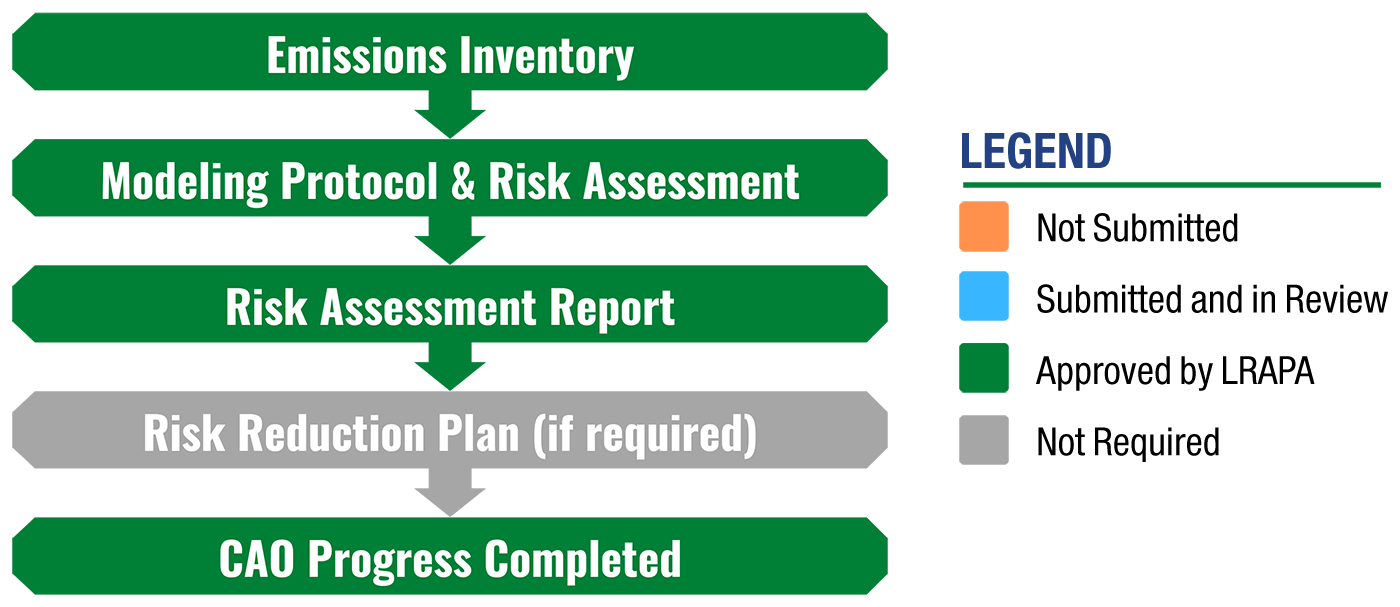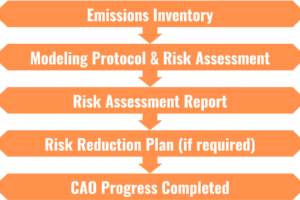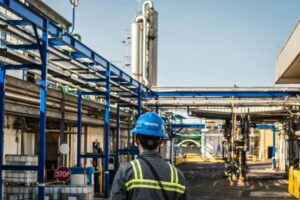SENECA SUSTAINABLE ENERGY, LLC
Cleaner Air Oregon ProfileHexion, Inc.
Cleaner Air Oregon (CAO) is a health-based permitting program that regulates emissions of toxic air contaminants from facilities based on risk to nearby communities. CAO requires facilities to report toxic air contaminant emissions, assess potential health risks to people nearby and reduce toxic air contaminant risk if it exceeds legal limits.
As part of the Cleaner Air Oregon process, each facility has a dedicated web page to provide communities access to facility information and updates on where it is involved in the process.
- Each step of the CAO risk assessment process has a section that includes LRAPA’s communications and deliverables from the facility.
- A color-coded graphic shows where a facility is in the Cleaner Air Oregon Process.
- For additional information and history of the program, visit the DEQ Cleaner Air Oregon website.
| Document Type | Anticipated Submittal Date | Approval Date |
|---|---|---|
| Emissions Inventory | 02/27/2020 | 06/15/2020 |
| Modeling Protocol | 07/08/2020 | 09/24/2020 |
| Risk Assessment Report | 01/03/2021 | 09/28/2021 |
| Risk Reduction Plan | N/A | N/A |
| CAO Completed | 05/14/2021 | 09/28/2021 |

Emissions Inventory
For an introduction to emissions inventories and why they matter, please see EPA’s Fact Sheet. A facility-specific emissions inventory timeline and associated documents are linked below.
December 2, 2019: LRAPA calls Seneca Sustainable Energy into the program
- LRAPA’s call in letter to Seneca Sustainable Energy.
February 27, 2020: Seneca Sustainable Energy submits Emissions Inventory and Categorically Insignificant Activities Form for LRAPA review
- Cover letter for emissions inventory submittal.
- Emissions Inventory: An Emissions Inventory is a list of each toxic air contaminant regulated under the Cleaner Air Oregon rules that a facility emits in a given year. The Emissions Inventory includes the amount of each toxic air contaminant emitted from each individual emissions-producing activity.
- Categorically Insignificant Activities (Form ED601): Categorically Insignificant Activities are activities that are likely to have insignificant emissions that are not part of a facility’s primary production process. Categorically Insignificant Activities are defined in LRAPA Title 12.
June 15, 2020: LRAPA approves the Emissions Inventory submitted by Seneca Sustainable Energy
Modeling Protocol & Risk Assessment
| A map of residential, child, acute, and worker exposure assignments used in the Modeling Protocol can be viewed by clicking here. |
July 8, 2020: Seneca Sustainable Energy provides initial Level 3 modeling protocol and risk assessment workplan.
- Seneca Sustainable Energy’s modeling protocol and risk assessment workplan.
- Seneca Sustainable Energy’s target organ analysis.
September 24, 2020: LRAPA approves the modeling protocol and risk assessment workplan.
- LRAPA’s modeling protocol and risk assessment workplan approval letter.
- Seneca Sustainable Energy’s cover letter for the revised modeling protocol and risk assessment workplan.
- Seneca Sustainable Energy’s revised modeling protocol and risk assessment workplan.
- Seneca Sustainable Energy’s revised target organ analysis.
Risk Assessment Report
January 3, 2021: Seneca Sustainable Energy submitted an initial Level 3 Risk Assessment report to LRAPA for review.
- Seneca Sustainable Energy’s initial Level 3 Risk Assessment report (2020-12-28 SSE Risk Assessment document).
- Seneca Sustainable Energy’s supporting spreadsheet for the initial Level 3 Risk Assessment report (CAO_SEN_2020_12_28 document).
April 1, 2021: Seneca Sustainable Energy submitted a final Level 3 Risk Assessment report incorporating changes requested by LRAPA.
- Seneca Sustainable Energy’s final Level 3 Risk Assessment report (2021-03-31 Final SSE Risk Assessment)
- Seneca Sustainable Energy’s supporting spreadsheet for the final Level 3 Risk Assessment report (CAO_SEN_2021_03_29)
September 8th, 2021: LRAPA hosted a virtual community meeting sharing the preliminary Risk Assessment and providing avenues for feedback.
- Presentation materials from the 9/8/2021 meeting (SSE_Community_Meeting_Slides).
- Meeting summary and notes from the 9/2/2021 meeting (SSE_Community_Meeting_Summary).
- A recording of the meeting is at the bottom of this webpage.
September 28th, 2021: LRAPA approves SSE’s Risk Assessment.
- LRAPA’s approval letter of SSE’s risk assessment. (SSE CAO Risk Assessment Approval Letter)
May 23rd, 2022: Seneca Sustainable Energy submits addendum to the Risk Assessment to account for updated Cleaner Air Oregon rules that evaluates emission units which were previously exempt.
- SSE’s risk assessment addendum. (2022-05-23 SSE Risk Assessment Addendum)
Risk Reduction Plan
Seneca Sustainable Energy, LLC (SSE) has yet to submit for this step of the Cleaner Air Oregon process. If necessary, this field will be updated once the facility reaches the Risk Reduction portion of CAO.
CAO Progress Completed
Seneca Sustainable Energy, LLC (SSE) has completed the Cleaner Air Oregon process. The permit was issued to the facility, and the review report was published, on September 20, 2022.
FACILITY
Seneca Sustainable Energy LLC operates a wood-fired electrical cogeneration power plant located at 29650 East Enid Road, Eugene, Oregon. The facility began operations in January 2011. The nameplate capacity of the turbine is 19.778 megawatts. The wood-fired boiler has a maximum heat input capacity of 352.8 MMBtu per hour and has a steam output of 200,000 pounds per hour. Learn more about LRAPA’s regulation of Seneca Sustainable Energy by viewing their current air permits.
Site Address
29650 East Enid Rd.
Eugene, Oregon, 97402
Current Air Permit
Permit type: Standard ACPD
Source Number: 200510
LRAPA Contact
Jonathan Wright
541-736-1056, ext. 236
Site Address
470 S. 2nd St.
Springfield, OR
Current Air Permit
Permit type: Standard ACDP
Source Number: 200510
LRAPA Contact
Jonathan Wright
541-736-1056, ext. 236

Legend
Facility
Hexion Inc. operates a resin manufacturing facility at 470 South Second Street in Springfield, Oregon. Formaldehyde is produced on-site and used primarily as a raw material for various types of resins. Wax emulsions are also produced at this facility. The facility uses boilers, scrubbers and baghouses to control emissions from various portions of the operation. Learn more about LRAPA’s regulation of Hexion by viewing their current air permit below.

Emissions Inventory
For an introduction to emissions inventories and why they matter, please see EPA’s Fact Sheet. A facility-specific emissions inventory timeline and associated documents are linked below.January 4, 2021: LRAPA calls Hexion, Inc. into the program
- LRAPA’s call in letter to Hexion, Inc.
January 29, 2021: Hexion requested an extension on the submittal date for the Emission Inventory because they have a new owner audit agreement with US EPA related to their Toxic Release Inventory emissions. This audit may affect Hexion’s emission calculations of compounds regulated by Cleaner Air Oregon
- Hexion’s Emission Inventory extension request letter.
February 12, 2021: After confirming with US EPA that Hexion is participating in a new owner audit agreement, LRAPA granted an extension on the due date for the Emission Inventory.
- LRAPA’s extension request response letter.
June 18, 2021: Hexion requested a second extension to the submittal date for the Emission Inventory because US EPA extended the due date for completion of the TRI new owner audit report.
- Hexion’s second Emissions Inventory extension request letter.
June 29, 2021: After confirming that US EPA has extended the due date for the TRI new owner audit report, LRAPA granted a second extension of the submittal date of the Emission Inventory.
- LRAPA’s second extension request response letter.
October 25, 2021: LRAPA extends Hexion’s Emissions Inventory to aligned with a December 10, 2021, due date listed in Stipulation and Final Order (SFO) No. 21-3839 signed on September 3, 2021.
- LRAPA’s third extension request response letter.
December 10, 2021: Hexion submits their emissions inventory.
- Hexion’s Compiled CAO Inventory.
- Hexion’s AQ520 Form.
March 7, 2022 and March 11, 2022: LRAPA reviewed Hexion’s submitted emissions inventory and requested modifications and clarifications. LRAPA expects a response to these requests by June 1, 2022.
Modeling Protocol & Risk Assessment
Hexion, Inc. – was called in into the Cleaner Air Oregon Program in January of 2021 and entered the Emissions Inventory Step of the Cleaner Air Oregon process. This field will be updated once the facility reaches this portion of CAO.
Risk Assessment Report
Hexion, Inc. – was called in into the Cleaner Air Oregon Program in January of 2021 and entered the Emissions Inventory Step of the Cleaner Air Oregon process. This field will be updated once the facility reaches this portion of CAO.
Risk Reduction Plan
Hexion, Inc. – was called in into the Cleaner Air Oregon Program in January of 2021 and entered the Emissions Inventory Step of the Cleaner Air Oregon process. This field will be updated once the facility reaches this portion of CAO.
CAO Progress Completed
Hexion, Inc. – was called in into the Cleaner Air Oregon Program in January of 2021 and entered the Emissions Inventory Step of the Cleaner Air Oregon process. This field will be updated once the facility reaches this portion of CAO.

